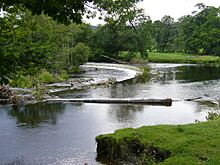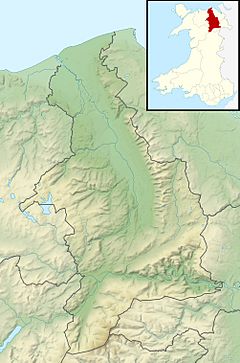Horseshoe Falls (Wales) facts for kids
Quick facts for kids Horseshoe Falls |
|
|---|---|

Horseshoe Falls
|
|
| Lua error in Module:Infobox_mapframe at line 185: attempt to index field 'wikibase' (a nil value). | |
| Location | About 3 miles (4.8 km) west of Llangollen |
| OS grid | SJ195433 |
| Coordinates | 52°58′52″N 3°11′57″W / 52.98111°N 3.19917°W |
| Type | artificial |
| Elevation | 330 ft (100 m) |
| Watercourse | River Dee |
| Average flow rate |
13.7 M gals per day (62 Mld) |
Horseshoe Falls (Welsh: Rhaeadr y Bedol) is a special type of dam called a weir. It is built on the River Dee in Wales. You can find it near Llantysilio Hall in Denbighshire, about 5 kilometers (3 miles) north-west of Llangollen. This important structure helps send water into the Llangollen Canal.
Contents
The Story of Horseshoe Falls
Building the Falls
Horseshoe Falls is a long weir, about 460 feet (140 meters) across. It was built to create a calm pool of water. This pool allows water to flow into the Llangollen Canal. A special law, called an Act of Parliament, allowed the building of the canal and the weir in 1804. This law was passed for the Ellesmere Canal Company.
The canal here was like a "feeder." It supplied water to the Ellesmere Canal. It also sent water to the Chester Canal near Nantwich. A famous civil engineer named Thomas Telford designed the weir and the canal feeder. Both were finished in 1808.
Saving the Canal
The weir was very important for keeping the canal open to Llangollen. In 1944, the owners of the canal system, the London, Midland and Scottish Railway, decided to close many parts of their network. However, they kept the canal from Llangollen to Nantwich open. This was because Horseshoe Falls was a major source of water for the whole system.
This decision helped the canal survive. In 1948, the canal was taken over by British Waterways. As fewer boats used the canal for trade, it found a new purpose. It began to transfer water from the River Dee to a reservoir near Hurleston Junction. In 2009, about 13.7 million gallons (62 million liters) of water flowed through the canal each day.
A Popular Waterway
Today, the canal has become one of the most popular places for boat trips in the country. The last 1.7 miles (2.7 kilometers) of the canal, from Llangollen to the Falls, are not wide enough for motorboats to turn around. However, you can walk along the path next to the canal all the way to the Falls.
World Heritage Site
Since 2009, Horseshoe Falls has been part of a World Heritage Site. This special site covers 11 miles (18 kilometers) of the Llangollen Canal. It stretches from just west of Horseshoe Falls to just beyond Chirk Aqueduct. The canal received World Heritage status because of its amazing engineering. Engineers had to find clever solutions to build a canal with no locks through very difficult land.


